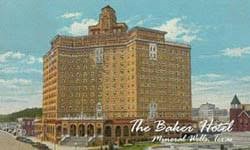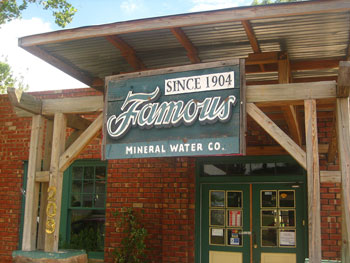
The Baker Hotel still dominates the landscape in Mineral Wells, Texas. In it’s heyday, it was an important attraction in North Texas.
When the first Anglo settlers migrated into Texas they discovered numerous natural springs. Water from underground pools that were filled to capacity gurgled up to the topsoil, providing water for livestock and humans. While we think natural springs were found only in the Hill Country of Central Texas, springs were found throughout the entire region that became Texas.
Natural springs contain minerals such as traces of iron, sulphur, and chalybeate that were considered extremely therapeutic for numerous health problems. At first, the settlers gathered to drink the waters, later they would bathe in the warm, healing pools.
In and around Austin’s Colony were immigrant groups from Germany and Central Europe where the practice of Homeopathic Medicine began and was quite popular. The new idea included holistic, natural, safe systems to stimulate the patient’s own healing power. Baths and mineral waters were part of the treatments. From the 1840s until the Civil War, taking the Baths or guzzling Mineral Waters were believed to cure almost every ailment. Anyone who owned such a natural spring did a prosperous business.

The healing properties attributed to the mineral waters from many springs in Texas created a thriving business for the property owners. Very few survive today. The Famous Mineral Water Company in Mineral Wells, TX, is one of the few that does.
Yet the good business went out the window, so to speak, during the Civil War and Reconstruction. Only as the country began to heal and prosper again did interest in Mineral Waters again attract attention. In some places like Greenville, housewives took the family buggy to the south side of town to purchase bottles of Mineral Water at the Mineral Heights Stand. In other towns swimming pools were constructed for bathing or swimming in the naturally warm waters. However, at every natural spring there were two pools, one for white women and one for white men. The springs were more than drinking mineral water. There were fine hotels with gourmet meals, entertainments, and social events.
But the depression of 1893 soon curtained such activities. As wealthy Texans and other Americans saw their incomes dissolve, taking the waters lost its appeal. Yet every time the stock market went up and fears of war abated, the siren call of the natural springs lured people to the warm waters.
With breaks for both World War I and World War II as well as the Great Depression, Mineral Waters were a profitable business in parts of Texas. One of the more popular places in North Texas was the town of Mineral Wells, where pools were no longer segregated by gender.
Patients of numerous ailments came for extended stays there. Mineral Water Company, founded in 1904, bottled and shipped water to all points in the United States. Tourists, patients, newly-weds, you name them, came for the excitement and the cure. Two of the most famous spots in Mineral Wells were the Crazy Water Hotel and the Baker Hotel. Legends of curing a demented woman with Crazy Water started the rush to Mineral Wells. The beautiful Baker Hotel was built after World War II. Rumors and tales of happenings there sounded as if it were an earlier version Las Vegas. It was the “Place to be Seen” in the late 40s and throughout the 50s.
By the way, the well at Mineral Heights in Greenville dried up as far as I know.
Today the Crazy Water is an assisted living facility. After many years of neglect, the Baker Hotel is in the process resurrection and restoration. We wish them well.
